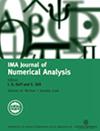A second-order accurate, positivity-preserving numerical scheme for the Poisson–Nernst–Planck–Navier–Stokes system
IF 2.4
2区 数学
Q1 MATHEMATICS, APPLIED
引用次数: 0
Abstract
In this paper we propose and analyse a second-order accurate (in both time and space) numerical scheme for the Poisson–Nernst–Planck–Navier–Stokes system, which describes the ion electro-diffusion in fluids. In particular, the Poisson–Nernst–Planck (PNP) equation is reformulated as a nonconstant mobility gradient flow in the energetic variational approach. The marker and cell finite difference method is chosen as the spatial discretization, which facilitates the analysis for the fluid part. In the temporal discretization the mobility function is computed by a second-order extrapolation formula for the sake of unique solvability analysis, while a modified Crank–Nicolson approximation is applied to the singular logarithmic nonlinear term. Nonlinear artificial regularization terms are added in the chemical potential part, so that the positivity-preserving property could be theoretically proved. Meanwhile, a second-order accurate, semi-implicit approximation is applied to the convective term in the PNP evolutionary equation, and the fluid momentum equation is similarly computed. In addition, an optimal rate convergence analysis is provided, based on the higher order asymptotic expansion for the numerical solution, and the rough and refined error estimate techniques. The following combined theoretical properties have been established for the second-order accurate numerical method: (i) second-order accuracy, (ii) unique solvability and positivity, (iii) total energy stability and (iv) optimal rate convergence. A few numerical results are displayed to validate the theoretical analysis.泊松-能斯特-普朗克-纳维-斯托克斯系统的二阶精确保正数值格式
本文提出并分析了描述离子在流体中的电扩散的泊松-能斯特-普朗克-纳维-斯托克斯系统的二阶精确(时间和空间)数值格式。特别是,在能量变分方法中,泊松-能-普朗克(PNP)方程被重新表述为非恒定迁移率梯度流。采用标记单元有限差分法进行空间离散化,便于对流体部分进行分析。在时间离散化中,为了进行唯一可解性分析,迁移函数采用二阶外推公式计算,而对奇异对数非线性项采用改进的Crank-Nicolson近似。在化学势部分加入非线性人工正则化项,从而从理论上证明了其保正性。同时,对PNP进化方程中的对流项采用二阶精确的半隐式近似,计算流体动量方程。此外,基于数值解的高阶渐近展开和粗糙和精细误差估计技术,给出了最优收敛速率分析。建立了二阶精确数值方法的以下综合理论性质:(i)二阶精度,(ii)唯一可解性和正性,(iii)总能量稳定性和(iv)最优收敛速度。数值结果验证了理论分析的正确性。
本文章由计算机程序翻译,如有差异,请以英文原文为准。
求助全文
约1分钟内获得全文
求助全文
来源期刊
CiteScore
5.30
自引率
4.80%
发文量
79
审稿时长
6-12 weeks
期刊介绍:
The IMA Journal of Numerical Analysis (IMAJNA) publishes original contributions to all fields of numerical analysis; articles will be accepted which treat the theory, development or use of practical algorithms and interactions between these aspects. Occasional survey articles are also published.

 求助内容:
求助内容: 应助结果提醒方式:
应助结果提醒方式:


